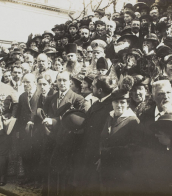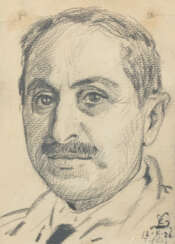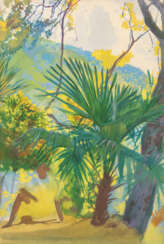Yevgeny Lanceray (1875 - 1946) — Auction price
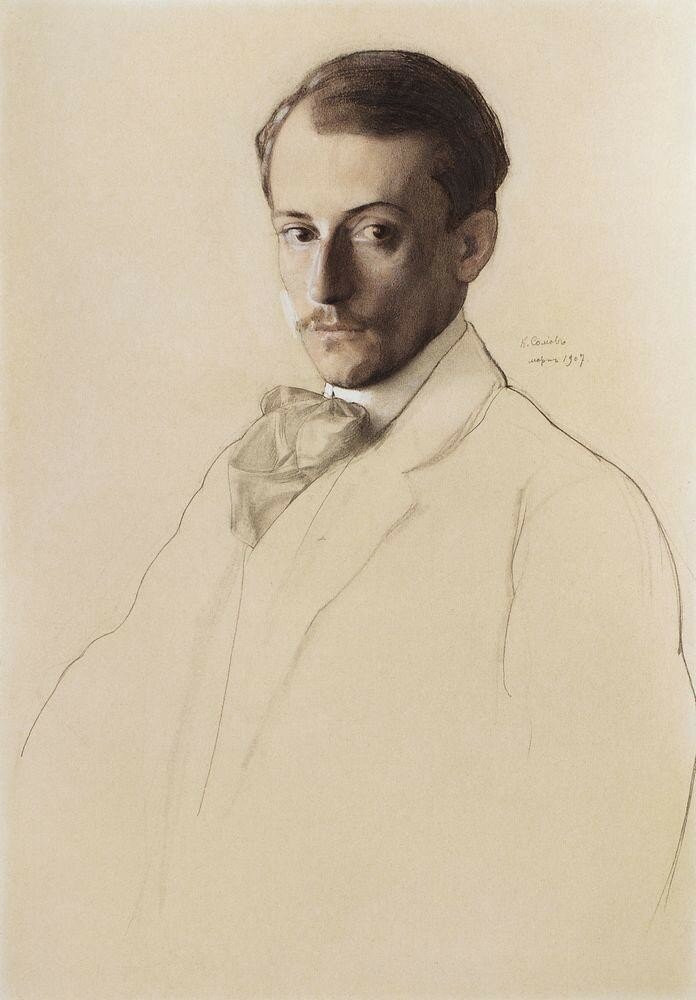
Yevgeny Yevgenyevich Lanceray (Russian: Евгений Евгеньевич Лансере), a Russian artist renowned for his graphic art, painting, sculpture, mosaic work, and illustrations, has left an indelible mark on the art world. Born in 1875 in Pavlovsk, Russia, Lanceray's art journey began early under the tutelage of prominent artists at the Drawing School of the Imperial Society for the Encouragement of the Arts in St. Petersburg. His educational odyssey continued in Paris at the Académie Colarossi and Académie Julian, places where he honed his artistic skills between 1896 and 1899.
Lanceray's association with the Mir iskusstva, an influential Russian art movement, saw him immerse in the Rococo's "sparkling dust," often drawing inspiration from 18th-century Russian history and art. Despite the societal upheaval following the 1917 Revolution, Lanceray remained in Russia, diverging from many contemporaries who chose to leave. His work during this period reflects a profound infatuation with Oriental themes, inspired by his time in Dagestan and travels to Japan and Turkey.
Perhaps one of his most significant contributions is the murals at the Moscow Kazansky railway station, where Lanceray's penchant for monumental painting and the integration of tempera paint showcased his mastery. Despite facing challenges with the Soviet regime and its constraints on artistic expression, Lanceray's legacy as a muralist, illustrator, and theater designer is undisputed. His recognition came in the form of the Stalin Prize and the title of People's Artist of the RSFSR, honors that underscored his contributions to Russian and Soviet art.
For collectors and experts in art and antiques, Lanceray's work represents a unique fusion of historical inspiration and personal expression, embodying the transitionary period of Russian art from pre-revolutionary aesthetics to Soviet realism. His murals, illustrations, and theatrical designs not only reflect his artistic versatility but also offer a window into the cultural and political shifts of his time.
To stay updated on sales and auction events related to Yevgeny Yevgenyevich Lanceray, sign up for our updates. This subscription will keep you informed about the latest discoveries and opportunities to own a piece of Russian art history.
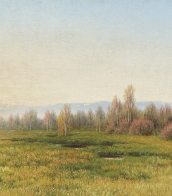

Yevgeny Yevgenyevich Lanceray (Russian: Евгений Евгеньевич Лансере), a Russian artist renowned for his graphic art, painting, sculpture, mosaic work, and illustrations, has left an indelible mark on the art world. Born in 1875 in Pavlovsk, Russia, Lanceray's art journey began early under the tutelage of prominent artists at the Drawing School of the Imperial Society for the Encouragement of the Arts in St. Petersburg. His educational odyssey continued in Paris at the Académie Colarossi and Académie Julian, places where he honed his artistic skills between 1896 and 1899.
Lanceray's association with the Mir iskusstva, an influential Russian art movement, saw him immerse in the Rococo's "sparkling dust," often drawing inspiration from 18th-century Russian history and art. Despite the societal upheaval following the 1917 Revolution, Lanceray remained in Russia, diverging from many contemporaries who chose to leave. His work during this period reflects a profound infatuation with Oriental themes, inspired by his time in Dagestan and travels to Japan and Turkey.
Perhaps one of his most significant contributions is the murals at the Moscow Kazansky railway station, where Lanceray's penchant for monumental painting and the integration of tempera paint showcased his mastery. Despite facing challenges with the Soviet regime and its constraints on artistic expression, Lanceray's legacy as a muralist, illustrator, and theater designer is undisputed. His recognition came in the form of the Stalin Prize and the title of People's Artist of the RSFSR, honors that underscored his contributions to Russian and Soviet art.
For collectors and experts in art and antiques, Lanceray's work represents a unique fusion of historical inspiration and personal expression, embodying the transitionary period of Russian art from pre-revolutionary aesthetics to Soviet realism. His murals, illustrations, and theatrical designs not only reflect his artistic versatility but also offer a window into the cultural and political shifts of his time.
To stay updated on sales and auction events related to Yevgeny Yevgenyevich Lanceray, sign up for our updates. This subscription will keep you informed about the latest discoveries and opportunities to own a piece of Russian art history.
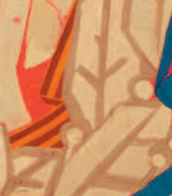

Yevgeny Yevgenyevich Lanceray (Russian: Евгений Евгеньевич Лансере), a Russian artist renowned for his graphic art, painting, sculpture, mosaic work, and illustrations, has left an indelible mark on the art world. Born in 1875 in Pavlovsk, Russia, Lanceray's art journey began early under the tutelage of prominent artists at the Drawing School of the Imperial Society for the Encouragement of the Arts in St. Petersburg. His educational odyssey continued in Paris at the Académie Colarossi and Académie Julian, places where he honed his artistic skills between 1896 and 1899.
Lanceray's association with the Mir iskusstva, an influential Russian art movement, saw him immerse in the Rococo's "sparkling dust," often drawing inspiration from 18th-century Russian history and art. Despite the societal upheaval following the 1917 Revolution, Lanceray remained in Russia, diverging from many contemporaries who chose to leave. His work during this period reflects a profound infatuation with Oriental themes, inspired by his time in Dagestan and travels to Japan and Turkey.
Perhaps one of his most significant contributions is the murals at the Moscow Kazansky railway station, where Lanceray's penchant for monumental painting and the integration of tempera paint showcased his mastery. Despite facing challenges with the Soviet regime and its constraints on artistic expression, Lanceray's legacy as a muralist, illustrator, and theater designer is undisputed. His recognition came in the form of the Stalin Prize and the title of People's Artist of the RSFSR, honors that underscored his contributions to Russian and Soviet art.
For collectors and experts in art and antiques, Lanceray's work represents a unique fusion of historical inspiration and personal expression, embodying the transitionary period of Russian art from pre-revolutionary aesthetics to Soviet realism. His murals, illustrations, and theatrical designs not only reflect his artistic versatility but also offer a window into the cultural and political shifts of his time.
To stay updated on sales and auction events related to Yevgeny Yevgenyevich Lanceray, sign up for our updates. This subscription will keep you informed about the latest discoveries and opportunities to own a piece of Russian art history.
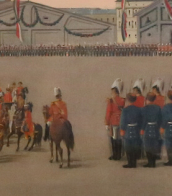

Yevgeny Yevgenyevich Lanceray (Russian: Евгений Евгеньевич Лансере), a Russian artist renowned for his graphic art, painting, sculpture, mosaic work, and illustrations, has left an indelible mark on the art world. Born in 1875 in Pavlovsk, Russia, Lanceray's art journey began early under the tutelage of prominent artists at the Drawing School of the Imperial Society for the Encouragement of the Arts in St. Petersburg. His educational odyssey continued in Paris at the Académie Colarossi and Académie Julian, places where he honed his artistic skills between 1896 and 1899.
Lanceray's association with the Mir iskusstva, an influential Russian art movement, saw him immerse in the Rococo's "sparkling dust," often drawing inspiration from 18th-century Russian history and art. Despite the societal upheaval following the 1917 Revolution, Lanceray remained in Russia, diverging from many contemporaries who chose to leave. His work during this period reflects a profound infatuation with Oriental themes, inspired by his time in Dagestan and travels to Japan and Turkey.
Perhaps one of his most significant contributions is the murals at the Moscow Kazansky railway station, where Lanceray's penchant for monumental painting and the integration of tempera paint showcased his mastery. Despite facing challenges with the Soviet regime and its constraints on artistic expression, Lanceray's legacy as a muralist, illustrator, and theater designer is undisputed. His recognition came in the form of the Stalin Prize and the title of People's Artist of the RSFSR, honors that underscored his contributions to Russian and Soviet art.
For collectors and experts in art and antiques, Lanceray's work represents a unique fusion of historical inspiration and personal expression, embodying the transitionary period of Russian art from pre-revolutionary aesthetics to Soviet realism. His murals, illustrations, and theatrical designs not only reflect his artistic versatility but also offer a window into the cultural and political shifts of his time.
To stay updated on sales and auction events related to Yevgeny Yevgenyevich Lanceray, sign up for our updates. This subscription will keep you informed about the latest discoveries and opportunities to own a piece of Russian art history.


Yevgeny Yevgenyevich Lanceray (Russian: Евгений Евгеньевич Лансере), a Russian artist renowned for his graphic art, painting, sculpture, mosaic work, and illustrations, has left an indelible mark on the art world. Born in 1875 in Pavlovsk, Russia, Lanceray's art journey began early under the tutelage of prominent artists at the Drawing School of the Imperial Society for the Encouragement of the Arts in St. Petersburg. His educational odyssey continued in Paris at the Académie Colarossi and Académie Julian, places where he honed his artistic skills between 1896 and 1899.
Lanceray's association with the Mir iskusstva, an influential Russian art movement, saw him immerse in the Rococo's "sparkling dust," often drawing inspiration from 18th-century Russian history and art. Despite the societal upheaval following the 1917 Revolution, Lanceray remained in Russia, diverging from many contemporaries who chose to leave. His work during this period reflects a profound infatuation with Oriental themes, inspired by his time in Dagestan and travels to Japan and Turkey.
Perhaps one of his most significant contributions is the murals at the Moscow Kazansky railway station, where Lanceray's penchant for monumental painting and the integration of tempera paint showcased his mastery. Despite facing challenges with the Soviet regime and its constraints on artistic expression, Lanceray's legacy as a muralist, illustrator, and theater designer is undisputed. His recognition came in the form of the Stalin Prize and the title of People's Artist of the RSFSR, honors that underscored his contributions to Russian and Soviet art.
For collectors and experts in art and antiques, Lanceray's work represents a unique fusion of historical inspiration and personal expression, embodying the transitionary period of Russian art from pre-revolutionary aesthetics to Soviet realism. His murals, illustrations, and theatrical designs not only reflect his artistic versatility but also offer a window into the cultural and political shifts of his time.
To stay updated on sales and auction events related to Yevgeny Yevgenyevich Lanceray, sign up for our updates. This subscription will keep you informed about the latest discoveries and opportunities to own a piece of Russian art history.
